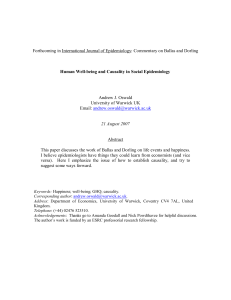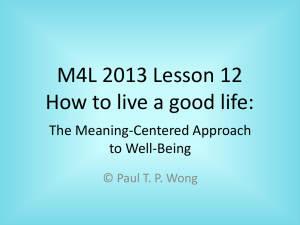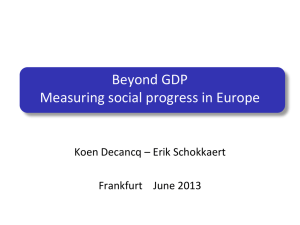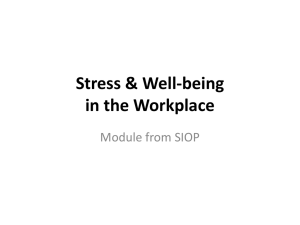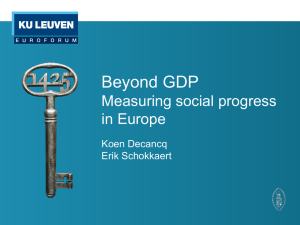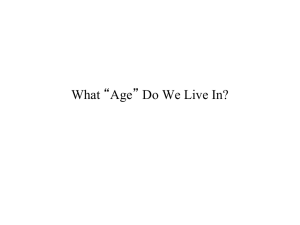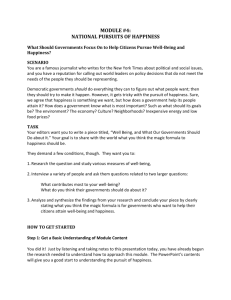OswaldHappinessLecture5
advertisement
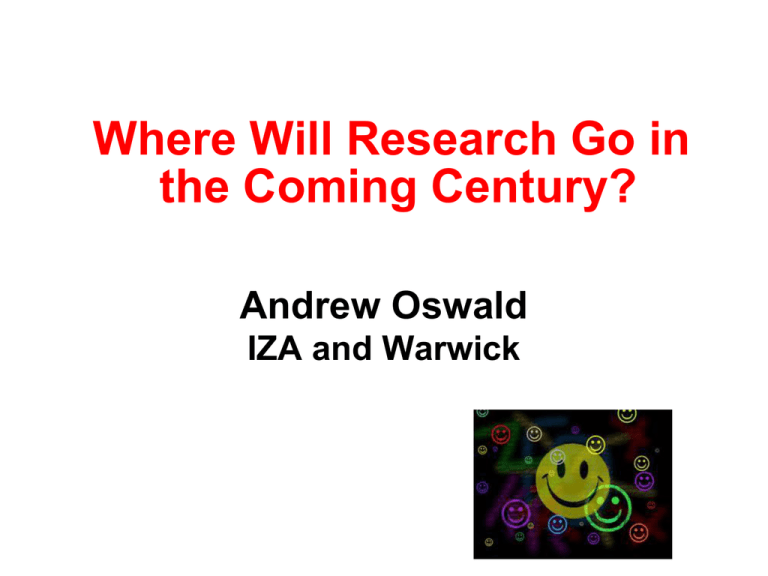
Where Will Research Go in the Coming Century? Andrew Oswald IZA and Warwick Our future? The dividing lines between health economists, well-being researchers, psychiatry researchers, biological scientists, etc, will become increasingly blurry. Today I’d like to suggest a number of ideas. Some perhaps unusual Self-reported health and number of daily portions of fruit and veg Chart 1d. Self reported health and portions of fruit & vegetables, Scotland, 2008/9 4.3 4.2 4.1 4 3.9 3.8 3.7 3.6 3.5 3.4 None Less than one One Two Three Four Five Six Seven Eight and over We find an equivalent relationship between mental well-being and the consumption of fruit and vegetables – peaking above the 5-a-day level. Now to one of the great mysteries: The pattern of a typical person’s happiness through life Average life satisfaction score 5.6 5.5 5.4 5.3 5.2 5.1 5.0 4.9 15-20 21-30 31-40 41-50 Age group 51-60 61-70 Arthur Stone, Angus Deaton, et al (2010) Overall well-being The next slide is unusual. Happiness plotted against age Happiness plotted against age Over the next few decades, it is likely that researchers will try intensively to understand the U shape in human happiness. One way to think is as Happiness = f(age) = a(age) + b(age) +c(age).... Stone et al in PNAS Work by Bert Van Landeghem on cohorts The probability of depression by age Males, LFS data set 2004-2006 0.02 Regression coefficient 0.015 0.01 0.005 0 -0.005 -0.01 1938 1942 1946 1950 1954 1958 1962 1966 Year of birth 1970 1974 1978 1982 1986 1990 Depression by age among females: LFS data 2004-2006Q2 0.002 Regression coefficient 0 -0.002 -0.004 -0.006 -0.008 -0.01 -0.012 -0.014 1942 1946 1950 1954 1958 1962 1966 Year of birth 1970 1974 1978 1982 1986 1990 The Relationship Between the Probability of Antidepressant Use and Age (European nations) 0.12 0.1 0.08 0.06 0.04 0.02 0 15 25 35 45 55 -0.02 -0.04 -0.06 Age 65 75 85 Biomarkers will be researcherd Could physiological measures, like heart rate and blood pressure, be used as proxies for well-being? Yes, but along the way we will have to accept some strange ideas. It is widely believed that high blood pressure is a sign of high mental strain. It is widely believed that high blood pressure is a sign of high mental strain. “The pathological (abnormal) consequences of mental stress are...chronic anxiety states, high blood pressure, heart disease, and addictive disorders...” Medicine.net Well, in a population, that seems completely wrong. Well, in a population, that seems completely wrong. There is an inverse relationship. People with higher blood pressure are actually less stressed (on a GHQ mental disorders measure). Here is a plot from our British data that conveys the flavour: GHQ Mental Strain and Systolic B.P. 11.6 11.4 11.2 Raw Plot of GHQ against systolic blood pressure percentiles in a sample of 66,729 people GHQ Score 11 10.8 y = -0.007x + 10.792 R² = 0.4589 10.6 10.4 10.2 10 9.8 9.6 0 10 20 30 40 50 60 70 Systolic Blood Pressure Percentiles 80 90 100 Typical GHQ mental-strain questions Typical GHQ mental-strain questions Aggregating across: Lost much sleep over worry? Felt constantly under strain? Felt you could not overcome your difficulties? Been feeling unhappy and depressed? Been losing confidence in yourself? Been thinking of yourself as a worthless person? Been able to enjoy your normal day-to-day activities? Mental well-being increases up to approximately 8-a-day. In heart biomarker equations, once fruit and vegetable consumption is held constant, there is an income gradient only in heart rate and Creactive protein. Next, consider the Stiglitz Commission’s Findings Stiglitz Report 2009: “Measures of .. objective and subjective wellbeing provide key information about people’s quality of life. Statistical offices [worldwide] should incorporate questions to capture people’s life evaluations, hedonic experiences … in their own survey.” P.16. Executive Summary of Commission Report. “Emphasis on growth is misguided” “Beyond GDP” “Measuring what matters” The Report’s Arguments The Report’s Arguments • Life is now more complex The time has come to adapt our system of measurement … to better reflect the structural changes which have characterized the evolution of modern economies. • Services dominate In effect, the growing share of services and the production of increasingly complex products make the measurement of output and economic performance more difficult than in the past. In the UK In the UK In 1900, there were 1 million coal miners (5% of the workforce). In the UK In 1900, there were 1 million coal miners (5% of the workforce). Today there are approximately 1,000. • We need to measure well-being per se A… unifying theme of the report, is that the time is ripe for our measurement system to shift emphasis from measuring economic production to measuring people’s well-being. • Inequality itself matters Recommendation 7: Quality-of-life indicators in all the dimensions covered should assess inequalities in a comprehensive way. • Official statistics should blend objective and subjective wellbeing data Recommendation 10: Measures of both objective and subjective well-being provide key information about people’s quality of life. Statistical offices should incorporate questions to capture people’s life evaluations, hedonic experiences and priorities in their own survey. • Sustainability must be a criterion Recommendation 11: Sustainability assessment requires a well-identified dashboard of indicators…the components of this dashboard should be … interpretable as variations of some underlying “stocks”. A monetary index of sustainability has its place in such a dashboard Those early points from Lecture 1 again: #1 ‘Happiness’ data offer us interesting potential as proxy-utility data. u = u(y, z, ..) #2 The next 20 years are likely to see economists work more and more with physiological and hard-science data. #3 Biomarker data will (slowly) be used more and more. #4 Empirically, there are strong relative effects on utility: #4 Empirically, there are strong relative effects on utility: u = u(y, y*) eg. if y* is others’ incomes. #5 A crucial role in social-science behaviour is played by the second derivative, v″, of the function utility = v(relative status)+ .. In humans (I shall argue) • Concavity of v(.) leads to imitation and herd behaviour • Convexity of v(.) leads to deviance. #6 The Stiglitz Commission’s ideas will eventually take hold. In closing: my hunches • Economists have not thought enough about the power of fruit and vegetables. • One day, I think it is likely that economists will start to study apes and humans within the same paper. • Economists will probably focus more and more on the human heart. • Welfare maximands will change. Where Will Research Go in the Coming Century? Andrew Oswald IZA and Warwick
